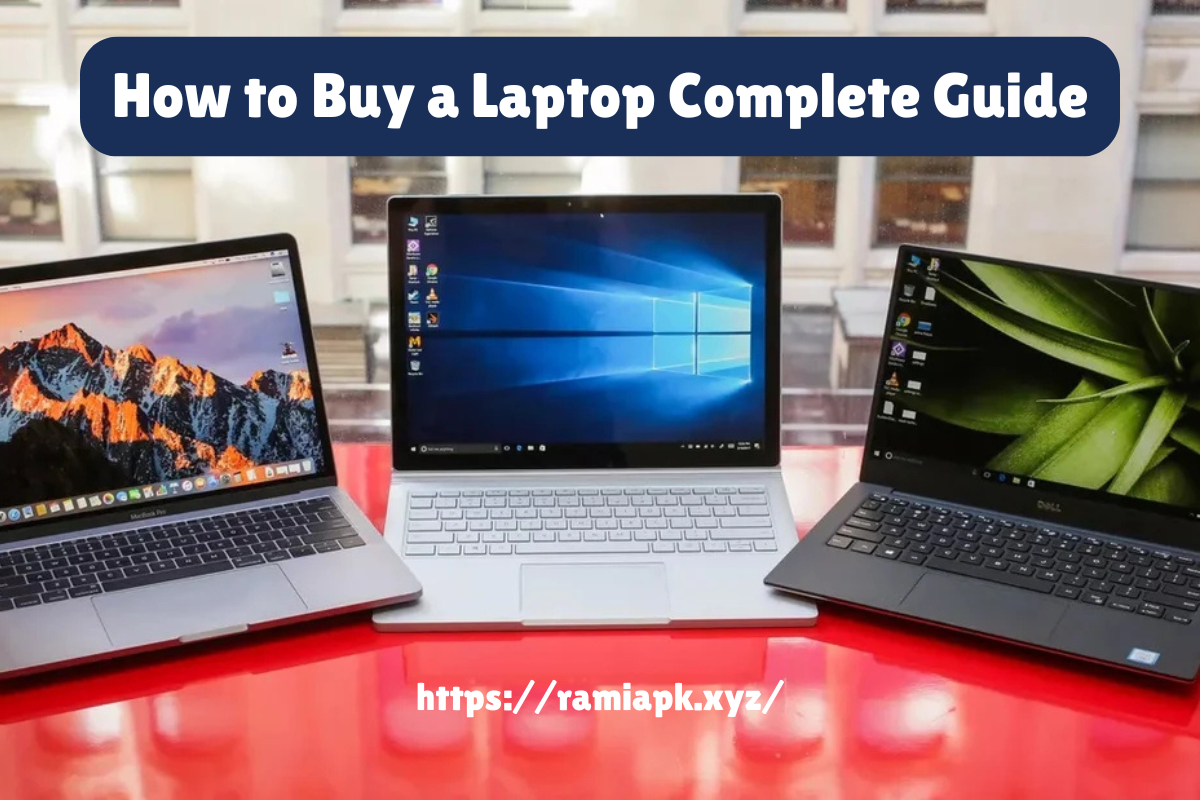How to Buy a Laptop can be an overwhelming task, especially with the variety of options available in the market. Whether you need a laptop for work, gaming, studies, or general use, it is essential to make an informed decision. This guide will walk you through the key factors to consider before purchasing a laptop, ensuring that you choose the perfect one for your needs.
1. Define Your Purpose
Before purchasing a laptop, you should determine the primary purpose of its use. Here are a few common usage scenarios:
- For Work and Business: You may need a lightweight laptop with a good battery life, excellent build quality, and professional software compatibility.
- For Gaming: A gaming laptop requires a powerful processor, dedicated graphics card, high refresh rate display, and efficient cooling system.
- For Students: Portability, battery life, and affordability should be prioritized. A decent processor and enough RAM for multitasking are also essential.
- For Creative Professionals: If you are a designer, video editor, or music producer, you need a laptop with a high-resolution display, powerful GPU, ample RAM, and fast storage.
- For General Use: If you need a laptop for browsing, media consumption, and occasional document editing, you can opt for a budget-friendly option with moderate specifications.
2. Choose the Right Operating System
The operating system (OS) plays a significant role in the functionality of your laptop. The three most common OS options are:
- Windows: A versatile operating system that supports a wide range of software and is ideal for business, gaming, and general use.
- macOS: Found in Apple’s MacBooks, macOS is known for its smooth performance, high security, and excellent build quality, making it a preferred choice for creative professionals.
- ChromeOS: Designed for Chromebooks, ChromeOS is lightweight and cloud-based, making it a great choice for students and casual users.
3. Consider the Specifications
The specifications determine the performance of your laptop. Below are the key components to consider:
a) Processor (CPU)
The processor is the brain of the laptop. Here are some common options:
- Intel Core i3/i5/i7/i9: i3 for basic tasks, i5 for moderate use, i7 for high performance, and i9 for extreme tasks like gaming and video editing.
- AMD Ryzen 3/5/7/9: Similar to Intel’s lineup but often more cost-effective with better graphics performance.
- Apple M1/M2/M3: Found in MacBooks, these processors offer incredible performance and efficiency.
b) RAM
RAM affects multitasking capabilities. The recommended RAM size based on usage:
- 4GB: Basic tasks like browsing and document editing.
- 8GB: Ideal for students and office work.
- 16GB: Suitable for professional work, gaming, and content creation.
- 32GB and above: For heavy tasks like 4K video editing and high-end gaming.
c) Storage
There are two main types of storage:
- HDD (Hard Disk Drive): More affordable but slower.
- SSD (Solid State Drive): Faster performance and better reliability. Recommended for most users.
A 256GB SSD is sufficient for casual users, while 512GB or more is ideal for professionals and gamers.
d) Display
Consider the display specifications:
- Size: 13-inch for portability, 15-inch for balance, and 17-inch for immersive experiences.
- Resolution: Full HD (1920×1080) is standard, while 4K (3840×2160) is ideal for professionals.
- Refresh Rate: 60Hz is standard, while 120Hz or higher is better for gaming and smooth visuals.
e) Graphics Card (GPU)
A dedicated GPU is essential for gaming, video editing, and 3D modeling. Some options include:
- Integrated Graphics: Suitable for general tasks and light gaming.
- NVIDIA GeForce GTX/RTX & AMD Radeon: High-performance GPUs for gaming and creative tasks.
f) Battery Life
If portability is essential, aim for a laptop with at least 6-8 hours of battery life. Ultrabooks and MacBooks generally have better battery performance.
g) Build Quality and Keyboard
- Material: Metal or aluminum chassis offers durability.
- Keyboard: Consider a backlit keyboard for low-light usage and comfortable key travel.
- Trackpad: A smooth and responsive trackpad improves the user experience.
4. Consider Your Budget
Laptops come in different price ranges:
- Budget ($300-$600): Basic laptops for browsing and light work.
- Mid-Range ($600-$1,200): Good for students, professionals, and casual gamers.
- High-End ($1,200+): Powerful laptops for gaming, creative work, and advanced computing.
5. Check Brand Reputation and Customer Support
Popular laptop brands include Apple, Dell, HP, Lenovo, ASUS, Acer, and MSI. Look for:
- Warranty and Support: Ensure good customer service and a reasonable warranty period.
- User Reviews: Check online reviews for real-world performance insights.
6. Buy from a Trusted Seller
You can buy laptops from various sources:
- Official Brand Stores: Best for warranty and genuine products.
- Authorized Retailers: Trusted electronic stores and malls.
- Online Marketplaces: Amazon, Best Buy, Newegg, and manufacturer websites offer discounts and user reviews.
- Second-Hand Markets: If buying used, check the condition, warranty, and seller reputation.
7. Compare Before Making a Decision
Before finalizing your purchase, compare different models based on:
- Features and Performance: Ensure the laptop meets your needs.
- Price and Discounts: Look for the best deals and seasonal offers.
- After-Sales Service: Consider warranty policies and repair options.
Conclusion
Buying a laptop requires careful consideration of various factors such as performance, budget, display, and battery life. By determining your needs, choosing the right specifications, and purchasing from a reputable seller, you can ensure that you invest in a laptop that meets your requirements. Take your time to research and compare different options to make an informed decision.
